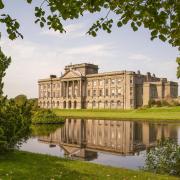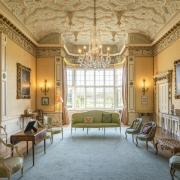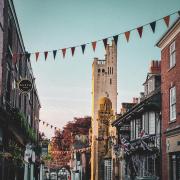On the outskirts of Wilmslow, close to the river Bollin and Manchester International Airport, stands the picturesque village of Styal. Quarry Bank Mill, built at the beginning of the Industrial Revolution, expanded rapidly to become one of the largest cotton manufacturers in the world, employing some 300 workers. Today both the village and the mill are a popular tourist attraction with visitors from all over the world.
It was Samuel Greg who built the mill in 1784, on land leased from Lord Stamford. At that time the mill was only half the size of today. The reason for choosing this location was the proximity of the waters of the Bollin, and of the Bridgewater Canal, which gave easy access to the port of Liverpool.
By 1796 the mill had doubled in size allowing for a second water wheel to be installed, to increase productivity.
The power of the river was harnessed by the installation of weirs, which increased the flow and speed of its water, thus driving the waterwheels that powered the mill. Quarry Bank House was built in 1797, alongside the mill and it was here Samuel Greg and his wife Hannah (née Lightbody) set up home. The textile magnate believed that by living so close to his mill he would be at the heart of his business and involved with the day-to-day operation of the mill. Samuel fathered a large number of children (records vary from 11 to 13).
Crucial to making the mill a great and profitable business was the acquisition of cheap labour, so an apprentice house was built to house up to 90 children, some as young as eight years old who would sleep two together in each bed. Each child was expected to sign an indenture that would tie them to the mill for many years to come. Many of these children would work an average of 72 hours a week, with only a Sunday off.
Samuel Greg also built houses for his adult workers, creating a large community later known as the Styal Estate, with 42 cottages constructed during the 1820s. The community grew to include Oak Cottages, also rented out to workers. Each property consisted of a kitchen, parlour and two bedrooms. The toilet was outside, along with a small garden. Rent was deducted from workers' wages, removing the need for a collector and preventing any worker falling into arrears. Oak School was set up to educate the children who worked in the mill, something unheard of in similar mills and workhouses at that time, and in 1822-1823 Norcliffe Chapel opened as a place of worship for the employees, with a Sunday school for the children.
Samuel and Hannah Greg believed in maintaining a healthy workforce and medical care was provided by staff physicians and surgeons. By 1847, the use of children as cheap labour in mills was outlawed. The mill and estate were eventually inherited by Samuel's son Robert Hyde Greg. A later descendant, Alexander Carlton Greg, donated the mill and estate to the National Trust in 1939. The mill was to carry on production until 1959. In 2013, the drama series The Mill was filmed at Quarry Bank Mill, based on true stories of the mill workers.
Today, the Quarry Bank Mill estate is open to the public with access to the mill via guided tours. Guided tours are also available for the Apprentice House, and Quarry Bank House.
You can view many of my local history films featuring historical locations around Cheshire and beyond by visiting my history channel, youtube.com/@Tvpresenter4history.
Look out for
The Apprentice House where pauper children as young as eight slept
The grounds, full of interesting features and wildlife
Styal village, still a living community, and a reminder of how workers lived
nationaltrust.org.uk/visit/cheshire-greater-manchester/quarry-bank



























